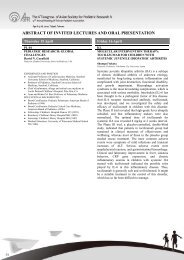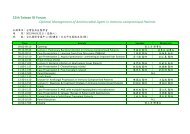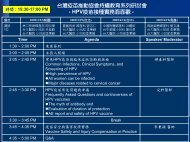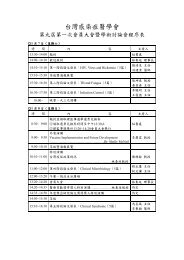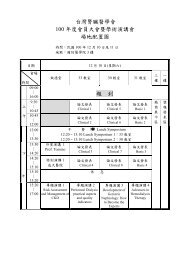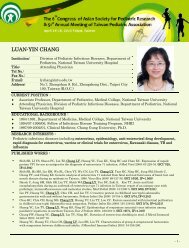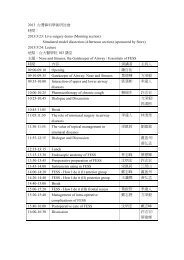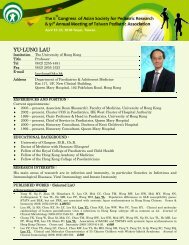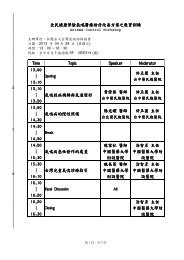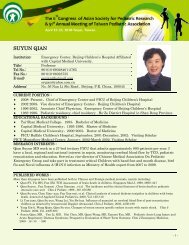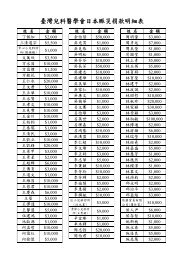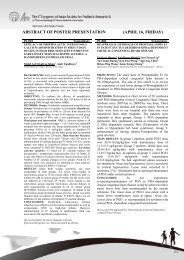ABSTRACT OF POSTER PRESENTATION (APRIL 17, SATURDAY)
ABSTRACT OF POSTER PRESENTATION (APRIL 17, SATURDAY)
ABSTRACT OF POSTER PRESENTATION (APRIL 17, SATURDAY)
You also want an ePaper? Increase the reach of your titles
YUMPU automatically turns print PDFs into web optimized ePapers that Google loves.
P2-039 Allergy/Immunology/Rheumatology P2-040 Allergy/Immunology/RheumatologyHOUSE DUST MITE AND CHILDHOODASTHMA AMONG ASIAN CHILDRENCheong Wooi CheahPaediatrics, International Medical University, MalaysiaBACKGROUND: Asthma is the most common chronicdisease among children and its prevalence is increasing byan astounding fifty percent every decade. The Phase Oneof International Study of Asthma and Allergies inChildhood (ISAAC) found that there is a marked variationin the prevalence of asthma symptoms between differentcountries. This variation can be up to 15-fold and is likelydue to environmental factors. House dust mite (HDM) isthe most potent indoor environmental allergen. To date,there are only a few studies on the sensitization profiles ofHDM in childhood asthma in South East Asia.OBJECTIVES: To determine the profiles of asthmaticchildren who are sensitized to the HDM,Dermatophagoides pteronyssinus (DP) andDermatophagoides farinae (DF). To determine associationof HDM sensitization to the control and severity ofchildhood asthma. To test the viability of using saliva inimmunoassay in associating the levels of Immunoglobulin(Ig)E in saliva with the severity and control of asthmaticpatients.METHODOLOGY: The subjects were unselectedchildren attending asthma follow-up clinic or admitted inthe ward in a tertiary hospital. They were deemed, onclinical grounds, to be suffering from asthma. Skin pricktest was performed on all the participants. Their saliva wascollected. A questionnaire regarding the control andseverity of asthmatic symptoms of the participant wereasked. The control and severity of asthma were assessed inaccordance to the Global Initiative for Asthma (GINA)guideline 2008. The saliva collected was selectedrandomly and the IgE specific to both DP and DF wasquantified by Enzyme Linked Immunosorbent assay(ELISA). Non-asthmatic children attending the generalclinic were recruited as the control group for comparison.RESULTS: Patients with poorer control have asignificantly higher percentage of DP and DF sensitizationas compared to patients with better control. There is nosignificant association between DP sensitization and theseverity of asthma. The mean IgE titre in subjects withcontrolled asthma is lower than that of subjects with partlycontrolled and uncontrolled asthma. The mean IgE titre insubjects with moderate and severe asthma is lower thanthat of subjects with mild asthma. However, the differenceis not statistically significant.CONCLUSION: There is subtle association between mitesensitivity and control (persistence) and severity ofchildhood asthma. IgE titre in expectorated (spitted) salivais not a good indicator for the severity and control ofasthma.[Keywords]House dust mite, Dermatophagoides pteronyssinus,Dermatophagoides farinae, childhood asthma, control, severityTHAPSIGARGIN AND FLAVIN ADENINEDINUCLEOTIDE EX VIVO TREATMENTRESCUES TRAFFICKING-DEFECTIVEGP91PHOX IN CHRONIC GRANULOMATOUSDISEASE LEUKOCYTESHuang Ya-Fang 1 , Liu Si-Yen 2 ,Yang Pei-Wen 3 , YenChia-Liang 4 , Shieh Chi-Chang 5Department of Microbiology and Immunology, National Cheng Kung University 1 ,Institute of Basic Medicine, National Cheng-Kung University Medical College 2 ,Institute of Microbiology and Immunology, National Cheng-Kung UniversityMedical College 3 , Institute of Basic Medicine, National Cheng-Kung UniversityMedical College 4 , Institute of Microbiology and Immunology; Department ofPediatrics, National Cheng-Kung University Medical College, Taiwan 5Mutations in leukocyte NADPH oxidase genes lead todefective respiratory burst in leukocytes and causechronic granulomatous diseases (CGD) in humans. Themost common form of CGD is caused by mutations inthe membrane-bound oxidase component gp91phoxwhich is encoded by the CYBB gene on theX-chromosome. We previously reported a patient withCYBB mutation (H338Y) which prevents theintracellular trafficking and expression of gp91phox onleukocytes. The capacity of the leukocytes to producereactive oxygen species (ROS) was rescued by treatmentwith thapsigargin and flavin adenine dinucleotide (FAD).The increase in ROS production was not due to theincrease of cytoplasmic calcium induced by thapsigarginbecause the treatment of calcium ionophore did not havethe same effect. Protein and cellular analyses onleukocytes and cells transfected with GFP-taggedgp91phox mutant showed that treated cells expressedmore Endo-H resistant gp91phox protein on cell surfaceand are more effective in killing bacteria. Thapsigarginand FAD-treated CGD leukocytes had enhanced activityin protecting mice from staphylococcus-inducedperitoneal abscess formation in a mouse model of CGD.These results indicate that thapsigargin-FAD ex vivotreatment is effective in rescuing the ROS-producingactivity of leukocytes in selected CGD patients.[Keywords]cell therapy, immunodeficiency, reactive oxygen species,chronic granulomatous disease, NADPH oxidase, calcium pumpinhibitor274



